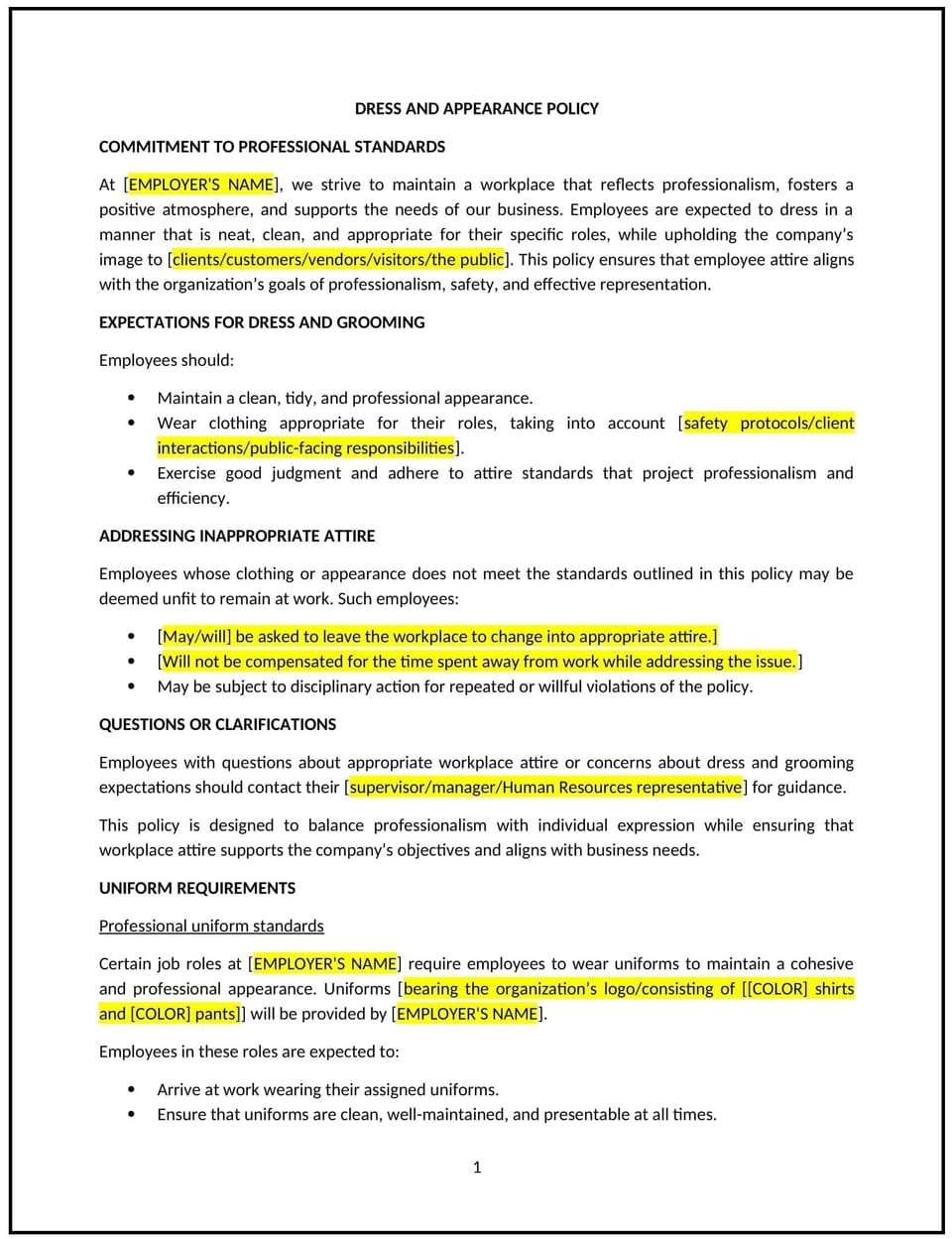Dress and appearance policy (Texas): Free template

Dress and appearance policy (Texas)
This dress and appearance policy is designed to help Texas businesses establish clear guidelines for employee attire and grooming standards. Whether businesses are setting expectations for professional dress, casual wear, or uniforms, this template provides a structured approach to managing employee appearance in a way that ensures professionalism and aligns with company culture.
By adopting this policy, businesses can create a consistent and respectful work environment while accommodating the diverse needs and preferences of employees.
How to use this dress and appearance policy (Texas)
- Define acceptable attire: Clearly specify what constitutes acceptable dress for employees, including appropriate clothing for different work environments (e.g., business casual, professional, or uniform requirements).
- Address grooming standards: Outline expectations for personal grooming, including hair, facial hair, and hygiene, ensuring that employees maintain a neat and professional appearance.
- Specify exceptions: Detail any exceptions to the policy, such as dress-down days, company events, or roles that require specific attire (e.g., uniforms for front-line employees).
- Address religious or cultural attire: Ensure that the policy accommodates religious or cultural attire requirements, such as headscarves, turbans, or religious jewelry, in accordance with Texas state laws and federal anti-discrimination regulations.
- Set consequences for violations: Clearly outline the actions that will be taken if employees fail to comply with the dress and appearance policy, such as verbal warnings, disciplinary action, or other corrective measures.
Benefits of using this dress and appearance policy (Texas)
This policy offers several benefits for Texas businesses:
- Promotes professionalism: A clear dress and appearance policy helps maintain a professional and cohesive image, which can positively impact the business’s reputation and employee morale.
- Ensures consistency: By setting clear guidelines, businesses ensure that all employees are held to the same standards, avoiding confusion and potential disagreements about what is acceptable.
- Enhances inclusivity: A well-structured policy can accommodate cultural, religious, and personal expression, ensuring that employees feel respected and valued.
- Reduces distractions: By establishing expectations for attire and grooming, businesses can minimize potential distractions that may arise from inappropriate clothing or grooming choices.
- Protects company image: Employees who adhere to the dress and appearance policy help maintain the company’s brand and public image, especially when interacting with clients, customers, or the public.
Tips for using this dress and appearance policy (Texas)
- Communicate clearly: Ensure all employees understand the dress and appearance policy and the specific guidelines for acceptable attire in their role or department.
- Be flexible when necessary: Consider allowing flexibility for employees who may need accommodations for medical, religious, or cultural reasons. The policy should specify how employees can request exceptions to the dress code.
- Reinforce the policy: Regularly remind employees about the dress and appearance policy, particularly during onboarding or as part of regular performance reviews.
- Lead by example: Managers and supervisors should model the appropriate attire and grooming standards to set an example for other employees.
- Review regularly: Update the policy as necessary to reflect changes in company culture, industry standards, or Texas state laws related to workplace attire and discrimination.
Q: What attire is acceptable under this policy?
A: The policy should specify what is considered professional or appropriate attire for the workplace, whether it’s business casual, professional dress, or uniforms, depending on the company’s needs and industry standards.
Q: Can employees wear casual clothes on certain days?
A: The policy may include provisions for casual or dress-down days where employees can wear more relaxed attire. These exceptions should be clearly defined and communicated.
Q: Does this policy accommodate religious or cultural attire?
A: Yes, the policy should comply with Texas state laws and federal anti-discrimination regulations by accommodating religious or cultural attire, such as headscarves or turbans, unless it creates an undue hardship for the business.
Q: What happens if an employee does not follow the dress code?
A: The policy should outline the consequences for violating the dress code, including verbal or written warnings, and potential disciplinary actions for repeated offenses.
Q: How often should this policy be reviewed?
A: The policy should be reviewed annually or whenever there are significant changes in company culture, Texas state laws, or federal regulations related to workplace attire.
This article contains general legal information and does not contain legal advice. Cobrief is not a law firm or a substitute for an attorney or law firm. The law is complex and changes often. For legal advice, please ask a lawyer.


